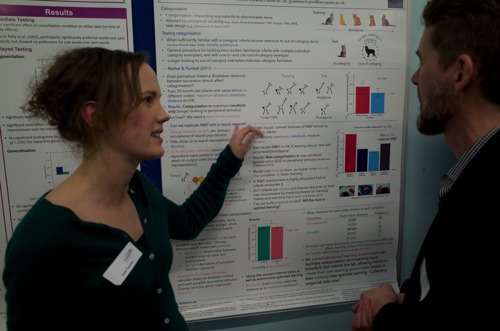The transition from preverbal to language-based cognition

The development of object knowledge and word learning are critical early components of the broader language acquisition task, and understanding the processes by which infants construct their first linguistic representations is vital to our understanding of language learning across development. Infants gain sophisticated knowledge about objects long before the onset of language, and during their first year of life infants’ ability to learn about objects gradually becomes more advanced. It is well-established that input variability has a profound effect on infants’ early knowledge of object categories. For example, the nature of the categories children form is related to the visual variability of the objects they encounter. Nevertheless, the processes underlying the interactions between object variability, variability in the environment, object labels, and infants’ intrinsic interest in engaging with specific information (curiosity) are not well understood.
This project addressed this question using a multidisciplinary approach, combining empirical work with computational modelling. Experimental work with infants extended the empirical basis of the delicate interplay between variability, labelling and categorization in infants’ learning. Computational modelling enabled us to develop precise theories of how the different aspects of the learning environment as well as infants’ intrinsic motivation contribute to what is learned by the infant, and to investigate the mechanisms governing the moment-by-moment development of word-category mappings.
This work is important because it focused on a crucial period in the infant’s cognitive development: the transition from preverbal learning to learning that is guided by language. A better understanding of how linguistic knowledge is integrated with what infants have learned before the onset of language has thereby furthered our understanding of subsequent language development.
Project Team: Gert Westermann (Lead), Ben Ambridge, Katie Twomey, Szilvia Linnert, Han Ke, Kirsty Dunn and Gemma Taylor
Start Date: October 2014
Duration: 3 years
(Work Package 5)
Data
Twomey, Katherine E and Ma, Lizhi and Westermann, Gert (2021). International Centre for Language and Communicative Development: All the Right Noises: Background Variability Helps Early Word Learning, 2014-2016. [Data Collection]. Colchester, Essex: UK Data Service. 10.5255/UKDA-SN-853872
Twomey, Katherine E and Westermann, Gert (2021). International Centre for Language and Communicative Development: Learned Labels Shape Pre-speech Infants' Object Representations, 2014-2015. [Data Collection]. Colchester, Essex: UK Data Service. 10.5255/UKDA-SN-853871
Twomey, Katherine E and Westermann, Gert (2021). International Centre for Language and Communicative Development: Beyond Words: Infants' Early Category Representations Are Shaped by Labels, 2014-2019. [Data Collection]. Colchester, Essex: UK Data Service. 10.5255/UKDA-SN-853873
Key Outputs:
Bergelson, E., Bergmann, C., Byers-Heinlein, K., Cristia, A., Cusack, R., Dyck, K., … Yurovsky, D. (in press). Quantifying sources of variability in infancy research using the infant-directed speech preference. Advances in Methods and Practices in Psychological Science. https://doi.org/10.31234/osf.io/s98ab
Twomey, K., & Westermann, G. (2019). Building the foundations of language: mechanisms of curiosity-driven learning. In: Horst, J., & Torkildsen, J. (eds.), International Handbook of Language Acquisition, pp. 102-114. Oxford, New York: Routledge
Horst, J. S., Twomey, K. E., Morse, A. F., Nurse, R. & Cangelosi, A. (2019). When object color is a red herring: Extraneous perceptual information hinders word learning via referent selection. IEEE Transactions on Cognitive and Developmental Systems. doi: 10.1109/TCDS.2019.2894507
Westermann, G., & Twomey, K. (2018). Computational models of word learning. In: Westermann, G. and Mani, N. (eds.), Early Word Learning, pp. 138-154. Oxford, New York: Routledge.
Taxitari, L., Twomey, K., Westermann, G., & Mani, N. (in press). The limits of infants' early word learning. Language Learning and Development. https://doi.org/10.1080/15475441.2019.1670184
Hilton, M., Twomey, K., & Westermann, G. (2019). Taking their eye off the ball: How shyness affects children’s attention during word learning. Journal of Experimental Child Psychology, 183, 134-145. https://doi.org/10.1016/j.jecp.2019.01.023
Capelier-Mourguy, A., Twomey, K., & Westermann, G. (2019). Neurocomputational models capture the effect of learned labels on infants' object and category representations. IEEE Transactions on Cognitive and Developmental Systems. https://doi.org/10.1109/TCDS.2018.2882920
Twomey, K., & Westermann, G. (2018). Curiosity-based learning in infants: A neurocomputational approach. Developmental Science, e12629. doi: 10.1111/desc.12629
Twomey, K. E. & Hilton, M. (2018). Word Learning. In Hupp, S., Jewell, J., & Nagel, M. C. (Eds.), Encyclopaedia of Child and Adolescent Development (1st Ed). Wiley.
Westermann, G. & Twomey, K. E. (2018). Computational models of word learning. In Westermann, G. and Mani, N. (Eds.), Early Word Learning. Routledge.
Twomey, K., Ma, L., and Westermann, G. (2017). All the right noises: Background variability helps early word learning. Cognitive Science. doi:10.1111/cogs.12539
Taylor, G., Monaghan, P., & Westermann, G. (2017). Investigating the association between children’s screen media exposure and vocabulary size in the UK. Journal of Children and Media.doi:10.1080/17482798.2017.1365737
Twomey, K. & Westermann. G. (2017). Learned labels shape pre-speech infants’ object representations. Infancy, 23, 61–73.doi:10.1111/infa.12201
Twomey, K. E., Smith, A., Monaghan, P. & Westermann, G. (2016). Neurocomputational Models of Cognitive Development and Processing: Proceedings of the 14th Neural Computation and Psychology Workshop (NCPW). Trends in Psychology and Artificial Intelligence. Hershey, PA: Information Science Reference.
Westermann, G., (2016). Experience-dependent brain development as a key to understanding the language system. Topics in Cognitive Science, 8, 446–458. DOI: 10.1111/tops.1219
Frost, R., Twomey, K., Taylor, G., Westermann, G., & Monaghan, P. (2015). Word for word. Nursery World, 27 July 2015, 21-23.
